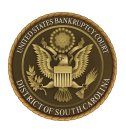In addition, effective February 22, 2008, involuntary bankruptcy petitions may be filed electronically via CMECF.
You are here
Chambers' Bulletins
02/2008
In addition, effective February 22, 2008, involuntary bankruptcy petitions may be filed electronically via CMECF.
The Clerk of Court has presented a proposal to significantly update the Court's web page within the next several months. It would be helpful at this stage to have the input of experienced and interested users of the web page. Therefore, the judges and the clerk are seeking user advice and comments within the next ten days from attorneys and bankruptcy paraprofessionals. Those interested would view the proposed web page in the automation training facilities at the U.S. Bankruptcy Court in Columbia. The judges are hopeful that attorneys and paraprofessionals from outside Columbia might also participate by arranging a visit in connection with upcoming hearings or 341 meetings. To volunteer for this opportunity, please contact Mark Tyan at scbcweb@scb.uscourts.gov or waites_chambers@scb.uscourts.gov as soon as possible.
Judge Waites has made Calendar Changes for his Docket in the Charleston Division beginning in March, 2008. A second day of court each month has been added and the Chapter 13 docket split into separate consent/ dispute days. Effective immediately, counsel should schedule Chapter 13 matters on the appropriate consent or dispute calendar as designated by Chambers Guidelines. However, to allow for the transition, dispute matters which have already been noticed or scheduled for March 20, 2008 will continue to be heard on that date. Both the Passive Notice and 362 calendars published by the Clerk's office will indicate the new dates.
By Judges Corner announcement on November 7, 2007, the Court reported that the Mortgage Issue Working Group recommended a 24-month sunset provision for ex parte relief under a 362 settlement order in a consumer case. A similar recommendation was also discussed with the Court's Advisory Committee in June of 2007. As a result, the judges of the Bankruptcy Court have agreed to adopt this recommendation in the following manner:
1) In the event of the filing of an affidavit of default under a previously entered 362 settlement order, if more than 24 months have elapsed since the entry of the settlement order, the Court will hold the ex parte order for a period of ten (10) days. In such situations, it is suggested that the party asserting default present a payment history which is sufficient to demonstrate the default.
Upon the expiration of ten (10) days without the filing of a counteraffidavit by the debtor disputing the fact of default and specifying the payments made, an order may be entered lifting the automatic stay.
2) For 362 settlement orders in consumer cases submitted on or after March 7, 2008, if the settlement order provides for ex parte relief upon subsequent default beyond a period of 24 months from the entry of the order, the Court will require the matter to remain on the calendar and will require the parties to appear to explain the need for inclusion of such a provision.
